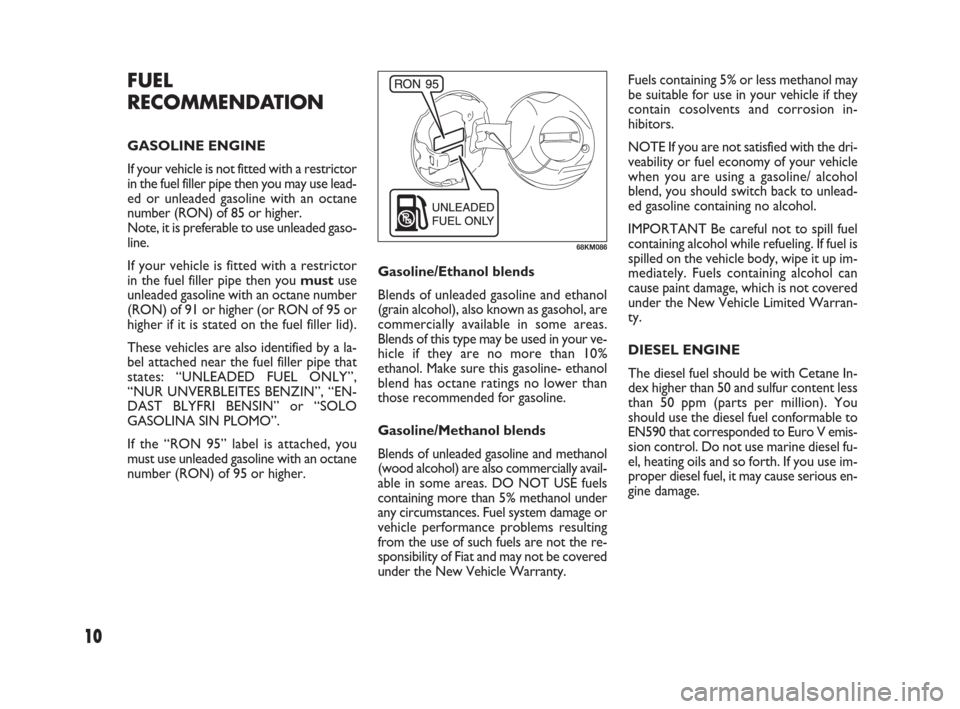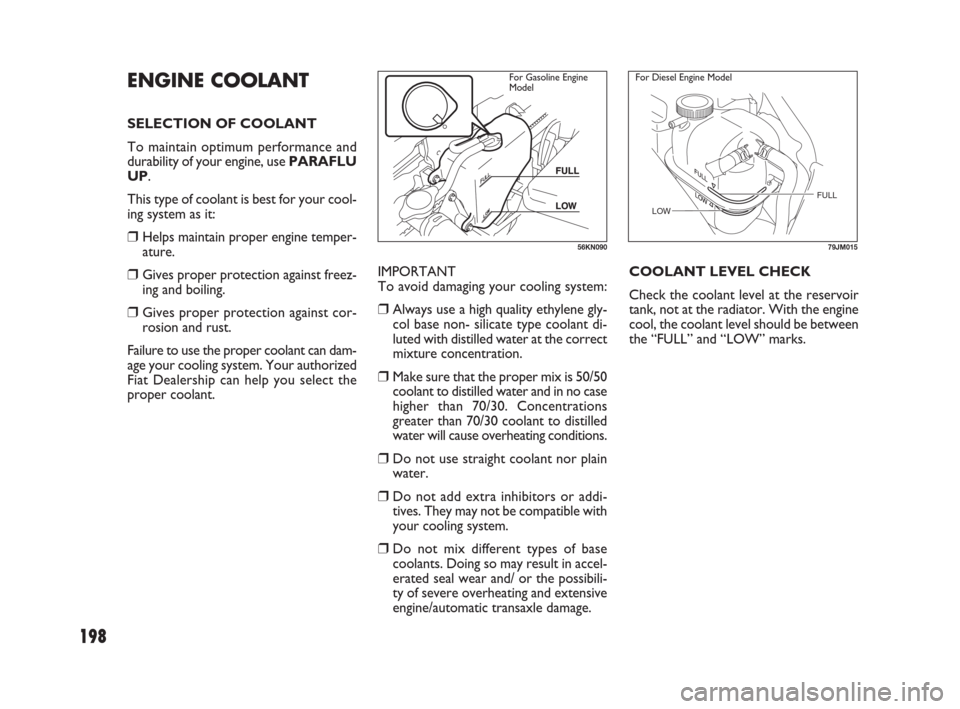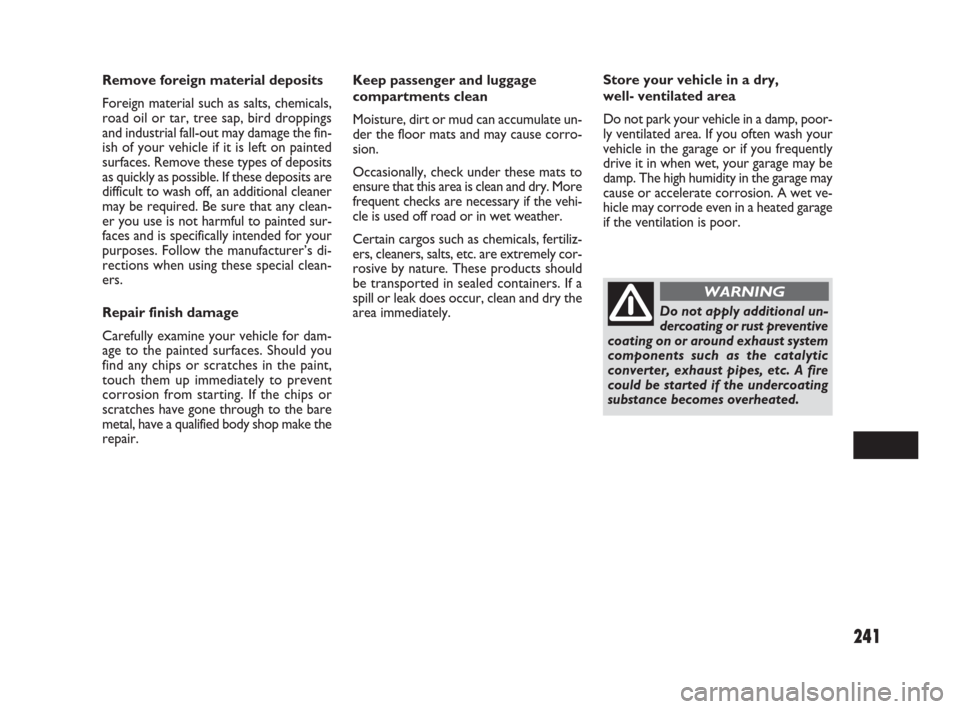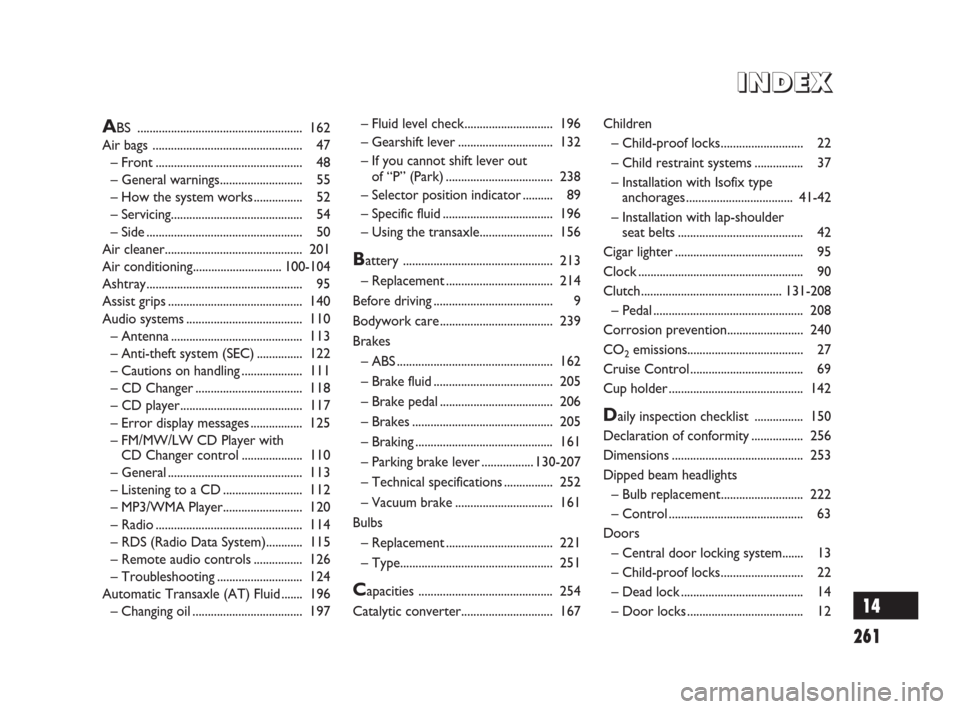2009 FIAT SEDICI oil type
[x] Cancel search: oil typePage 11 of 270

10
Gasoline/Ethanol blends
Blends of unleaded gasoline and ethanol
(grain alcohol), also known as gasohol, are
commercially available in some areas.
Blends of this type may be used in your ve-
hicle if they are no more than 10%
ethanol. Make sure this gasoline- ethanol
blend has octane ratings no lower than
those recommended for gasoline.
Gasoline/Methanol blends
Blends of unleaded gasoline and methanol
(wood alcohol) are also commercially avail-
able in some areas. DO NOT USE fuels
containing more than 5% methanol under
any circumstances. Fuel system damage or
vehicle performance problems resulting
from the use of such fuels are not the re-
sponsibility of Fiat and may not be covered
under the New Vehicle Warranty. Fuels containing 5% or less methanol may
be suitable for use in your vehicle if they
contain cosolvents and corrosion in-
hibitors.
NOTE If you are not satisfied with the dri-
veability or fuel economy of your vehicle
when you are using a gasoline/ alcohol
blend, you should switch back to unlead-
ed gasoline containing no alcohol.
IMPORTANT Be careful not to spill fuel
containing alcohol while refueling. If fuel is
spilled on the vehicle body, wipe it up im-
mediately. Fuels containing alcohol can
cause paint damage, which is not covered
under the New Vehicle Limited Warran-
ty.
DIESEL ENGINE
The diesel fuel should be with Cetane In-
dex higher than 50 and sulfur content less
than 50 ppm (parts per million). You
should use the diesel fuel conformable to
EN590 that corresponded to Euro V emis-
sion control. Do not use marine diesel fu-
el, heating oils and so forth. If you use im-
proper diesel fuel, it may cause serious en-
gine damage.
FUEL
RECOMMENDATION
GASOLINE ENGINE
If your vehicle is not fitted with a restrictor
in the fuel filler pipe then you may use lead-
ed or unleaded gasoline with an octane
number (RON) of 85 or higher.
Note, it is preferable to use unleaded gaso-
line.
If your vehicle is fitted with a restrictor
in the fuel filler pipe then you mustuse
unleaded gasoline with an octane number
(RON) of 91 or higher (or RON of 95 or
higher if it is stated on the fuel filler lid).
These vehicles are also identified by a la-
bel attached near the fuel filler pipe that
states: “UNLEADED FUEL ONLY”,
“NUR UNVERBLEITES BENZIN”, “EN-
DAST BLYFRI BENSIN” or “SOLO
GASOLINA SIN PLOMO”.
If the “RON 95” label is attached, you
must use unleaded gasoline with an octane
number (RON) of 95 or higher.
68KM086
009-056 SEDICI LUM FL GB 1E 19-06-2009 14:11 Pagina 10
Page 191 of 270

MAINTENANCE RECOMMENDED UNDER SEVERE DRIVING CONDITIONS
If the vehicle is usually used under the conditions corresponding to any severe condition code given below, it is recommended that
applicable maintenance operation be performed at the particular interval as given in the chart below.
190
G----
HTrailer towing (if admitted)
Maintenance Operation
IInspect and correct or replace if necessary
RReplace or Change
NOTE 4WD: 4-wheel drive Severe condition code
ARepeated short trips
BDriving on rough and/or muddy roads
CDriving on dusty roads
DDriving in extremely cold weather and/or salted roads
ERepeated short trips in extremely cold weather
FLeaded fuel use
Severe Condition Code
B C D
A D
A C D E F H
A C D E H
A B C E F H
C
B E H
B C D H
B D E H
B E H
C D
Maintenance Interval
Every 15,000 km (9,000 miles) or 12 months
Every 45,000 km (27,000 miles) or 36 months
Every 36 months
Every 7,500 km (4,500 miles) or 6 months
Every 7,500 km (4,500 miles) or 6 months
Every 30,000 km (18,000 miles) or 24 months
Every 10,000 km (6,000 miles) or 8 months
Every 2,500 km (1,500 miles)
Every 30,000 km (18,000 miles) or 24 months
Every 30,000 km (18,000 miles) or 24 months
Every 15,000 km (9,000 miles) or 12 months
Every 15,000 km (9,000 miles) or 12 months
First time only:
15,000 km (9,000 miles) or 12 months
Second time and after:
Every 30,000 km (18,000 miles) or 24 months
reckoning from 0 km (0 mile) or 0 month
Every 15,000 km (9,000 miles) or 12 months
Every 45,000 km (27,000 miles) or 36 months Maintenance
Engine accessory drive belt (V-rib belt)
Camshaft timing belt (Diesel engine)
Engine oil and oil filter (Gasoline engine)
Engine oil and oil filter (Diesel engine)
Spark plugs
Air cleaner filter element
(Inspect or replace more frequently if necessary)
Automatic transaxle fluid change
Wheel bearings
Drive axle boots/Propeller shaft (4WD)
Manual transaxle oil/Transfer oil (4WD)
Differential oil (4WD)
Air conditioner filter element (for versions/markets, where provided)
(Clean more frequently if the air flow from the air conditioner
decreases)Maintenance
Operation
I
R
R
R
R
R
R
I
R
R
I
I
R
I
R Iridium plug
(Highly recommended)
Nickel plug
(Standard type)
183-230 SEDICI LUM FL GB 1E 19-06-2009 11:00 Pagina 190
Page 199 of 270

198
IMPORTANT
To avoid damaging your cooling system:
❒Always use a high quality ethylene gly-
col base non- silicate type coolant di-
luted with distilled water at the correct
mixture concentration.
❒Make sure that the proper mix is 50/50
coolant to distilled water and in no case
higher than 70/30. Concentrations
greater than 70/30 coolant to distilled
water will cause overheating conditions.
❒Do not use straight coolant nor plain
water.
❒Do not add extra inhibitors or addi-
tives. They may not be compatible with
your cooling system.
❒Do not mix different types of base
coolants. Doing so may result in accel-
erated seal wear and/ or the possibili-
ty of severe overheating and extensive
engine/automatic transaxle damage.
ENGINE COOLANT
SELECTION OF COOLANT
To maintain optimum performance and
durability of your engine, use PARAFLU
UP.
This type of coolant is best for your cool-
ing system as it:
❒Helps maintain proper engine temper-
ature.
❒Gives proper protection against freez-
ing and boiling.
❒Gives proper protection against cor-
rosion and rust.
Failure to use the proper coolant can dam-
age your cooling system. Your authorized
Fiat Dealership can help you select the
proper coolant.
56KN090
For Gasoline Engine
Model
COOLANT LEVEL CHECK
Check the coolant level at the reservoir
tank, not at the radiator. With the engine
cool, the coolant level should be between
the “FULL” and “LOW” marks.
LOWFUL
L FULLFULL
79JM015
For Diesel Engine Model
183-230 SEDICI LUM FL GB 1E 19-06-2009 11:00 Pagina 198
Page 203 of 270

202
To remove the air cleaner element:
❒Remove the air cleaner inlet hose (1).
❒Remove the bolts (2), loosen the bolt
(3) and lift the air cleaner case (4) di-
rectly above.
IMPORTANT When lifting the air clean-
er, make sure the air cleaner does not in-
terfere the engine oil dipstick (5) to avoid
damage the dipstick.
❒Unclamp the side clamps, and remove
the element from the air cleaner case.
If it appears to be dirty, replace it with
a new one.
SPARK PLUGS
(Gasoline engine)
For Nickel spark plugs (traditional type):
You should inspect spark plugs periodi-
cally for carbon deposits. When carbon
accumulates on a spark plug, a strong
spark may not be produced. Remove car-
bon deposits with a wire or pin and adjust
the spark plug gap.
To access the spark plugs:
❒Remove the air cleaner case. Refer to
“Air Cleaner” in this section.
❒If necessary, disconnect the coupler (1)
while pushing the release lever.
❒Remove the ignitor bolts.
❒Pull the spark plug boots out.
NOTE When installation, make sure the
wires, couplers, sealing rubber of air clean-
er assy and washers, are correctly re-
turned in place.
(1)
80JM125
60G102
CorrectWrong
79JM016
For Diesel Engine Model
183-230 SEDICI LUM FL GB 1E 19-06-2009 11:00 Pagina 202
Page 242 of 270

241
Keep passenger and luggage
compartments clean
Moisture, dirt or mud can accumulate un-
der the floor mats and may cause corro-
sion.
Occasionally, check under these mats to
ensure that this area is clean and dry. More
frequent checks are necessary if the vehi-
cle is used off road or in wet weather.
Certain cargos such as chemicals, fertiliz-
ers, cleaners, salts, etc. are extremely cor-
rosive by nature. These products should
be transported in sealed containers. If a
spill or leak does occur, clean and dry the
area immediately.Store your vehicle in a dry,
well- ventilated area
Do not park your vehicle in a damp, poor-
ly ventilated area. If you often wash your
vehicle in the garage or if you frequently
drive it in when wet, your garage may be
damp. The high humidity in the garage may
cause or accelerate corrosion. A wet ve-
hicle may corrode even in a heated garage
if the ventilation is poor. Remove foreign material deposits
Foreign material such as salts, chemicals,
road oil or tar, tree sap, bird droppings
and industrial fall-out may damage the fin-
ish of your vehicle if it is left on painted
surfaces. Remove these types of deposits
as quickly as possible. If these deposits are
difficult to wash off, an additional cleaner
may be required. Be sure that any clean-
er you use is not harmful to painted sur-
faces and is specifically intended for your
purposes. Follow the manufacturer’s di-
rections when using these special clean-
ers.
Repair finish damage
Carefully examine your vehicle for dam-
age to the painted surfaces. Should you
find any chips or scratches in the paint,
touch them up immediately to prevent
corrosion from starting. If the chips or
scratches have gone through to the bare
metal, have a qualified body shop make the
repair.
Do not apply additional un-
dercoating or rust preventive
coating on or around exhaust system
components such as the catalytic
converter, exhaust pipes, etc. A fire
could be started if the undercoating
substance becomes overheated.
WARNING
239-244 SEDICI LUM FL GB 1E 19-06-2009 11:07 Pagina 241
Page 262 of 270

261
– Fluid level check............................. 196
– Gearshift lever............................... 132
– If you cannot shift lever out
of “P” (Park)................................... 238
– Selector position indicator .......... 89
– Specific fluid.................................... 196
– Using the transaxle........................ 156
Battery ................................................. 213
– Replacement ................................... 214
Before driving....................................... 9
Bodywork care..................................... 239
Brakes
– ABS................................................... 162
– Brake fluid....................................... 205
– Brake pedal ..................................... 206
– Brakes.............................................. 205
– Braking ............................................. 161
– Parking brake lever.................130-207
– Technical specifications ................ 252
– Vacuum brake ................................ 161
Bulbs
– Replacement ................................... 221
– Type.................................................. 251
Capacities ............................................ 254
Catalytic converter.............................. 167Children
– Child-proof locks........................... 22
– Child restraint systems ................ 37
– Installation with Isofix type
anchorages...................................41-42
– Installation with lap-shoulder
seat belts......................................... 42
Cigar lighter .......................................... 95
Clock ...................................................... 90
Clutch..............................................131-208
– Pedal................................................. 208
Corrosion prevention......................... 240
CO
2emissions...................................... 27
Cruise Control ..................................... 69
Cup holder ............................................ 142
Daily inspection checklist ................ 150
Declaration of conformity ................. 256
Dimensions........................................... 253
Dipped beam headlights
– Bulb replacement........................... 222
– Control ............................................ 63
Doors
– Central door locking system....... 13
– Child-proof locks........................... 22
– Dead lock ........................................ 14
– Door locks ...................................... 12
ABS ...................................................... 162
Air bags ................................................. 47
– Front................................................ 48
– General warnings........................... 55
– How the system works ................ 52
– Servicing........................................... 54
– Side................................................... 50
Air cleaner............................................. 201
Air conditioning.............................100-104
Ashtray................................................... 95
Assist grips............................................ 140
Audio systems...................................... 110
– Antenna ........................................... 113
– Anti-theft system (SEC) ............... 122
– Cautions on handling .................... 111
– CD Changer................................... 118
– CD player........................................ 117
– Error display messages................. 125
– FM/MW/LW CD Player with
CD Changer control .................... 110
– General ............................................ 113
– Listening to a CD .......................... 112
– MP3/WMA Player.......................... 120
– Radio................................................ 114
– RDS (Radio Data System)............ 115
– Remote audio controls ................ 126
– Troubleshooting ............................ 124
Automatic Transaxle (AT) Fluid ....... 196
– Changing oil .................................... 197
I I
N N
D D
E E
X X
14
261-268 SEDICI LUM FL GB 1E 19-06-2009 11:12 Pagina 261